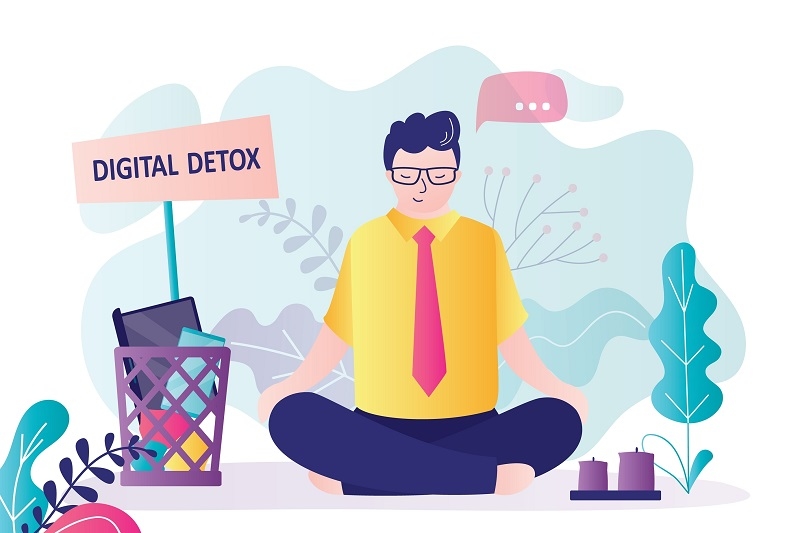Digital Detox for Employees: A Simple Way to Boost Wellbeing

Technology has made work easier and quicker, but it has also introduced new issues. Most employees currently spend long hours staring at screens answering emails, participating in online meetings, and receiving notifications. Continuous contact with the screens impacts health, concentration, and even relations. In response to this, various organizations are presently discussing digital detox in the workplace.
A digital detox does not imply not using technology. It merely involves brief periods of disconnection with devices so that the mind and body can take a break. This article will explain why digital detox is necessary and how it benefits employee well-being, as well as what companies can do to support it through employee well-being programs and initiatives.
What is Digital Detox in the Workplace?
Digital detox in the workplace refers to inviting employees to have a phone, laptop, or other screen-free time. Depending on the situation, this can be in minutes, hours, or as long as a day. The motto is to apply technology to situations where there is a need and not allow technology to dominate every life.
For example:
- They also should not normally look at their emails during lunch.
- Ignore unnecessary notifications during meetings.
- Check emails at a definite time
This contributes to the health and well-being of the employees and keeps individuals in check.
Must Read: Truth Behind Quiet Quitting And Its Impact On Productivity
Why Digital Detox for Employees is Important
Digital Detox of Employees at the workplace is important for several reasons. Some of them are listed below:
Less Stress and Burnout
The pressure is always on. Employees feel that they must answer at once, even after work, which creates stress and slowly results in burnout. Digital detox relieves them of this weight and gives their brain time to rest.
Better Mental Health
Continuous screen time is energy-consuming. A break can also restore a positive mood, clear the mind, and reduce anxiety. It relaxes employees and makes them more focused.
Improved Sleep
The effects of blue light and continuous stimulation keep us awake with late-night screen time. Workplaces that come together to enforce digital detox among their staff to improve their sleep allow them to foster employee well-being in general.
Better Attention and concentration
Notifications are distracting. Digital detox enables workers to concentrate on their work without distractions, which leads to greater efficiency in their performance and quality.
Stronger Relationships
There is more face-to-face communication and less time spent staring at screens. This develops teamwork, friendship, and trust at the workplace and at the family level.
Role of Employee Wellbeing Programs
Most organizations already have employee well-being programs, perhaps with health check-ups, counseling, or fitness sessions! Adding digital detox will up their game. For instance:
- Workshops on managing screen time.
- Training sessions for mindful device use.
- Policies regarding after-hours communications.
With a berth for digital detox, the employee wellness initiatives brand the company as one that values productivity and leisure equally. This balance is beneficial for employee health and well-being.

Practical Employee Wellbeing Initiatives for Digital Detox
Here are some easy steps companies can take to carry out digital detox for employees:
Clear Boundaries for Working Hours
Set rules about emails and calls after office hours. Allow urgent contact only when necessary. This will help employees disconnect without feeling guilty.
Device-Free Zones
Create spaces where calls and phones are put away, like cafeterias and meeting rooms. This gives time for human conversation and limits screen fatigue.
Mindful Breaks
Encourage employees to take screen-free breaks. A walk, a stretch, or just sitting quietly allows for a fresh perspective on the mind.
Control Notifications
People should be encouraged to turn off notifications unrelated to work during office hours to ensure that any attention is counted for relevant work.
Digital Detox Challenges
Events like No-Screen Lunch or Log-Out Weekend should be fun. These initiatives raise awareness and nurture balanced living.
These are small but powerful employee wellness initiatives that any workplace can adopt.
Don’t Miss: Top Traits of Successful Leaders for Career Growth
Best Practices for Companies
Companies must take specific initiatives to make digital detox a practice at the workplace. Check out some of the measures below:
Leaders Should Set an Example
If managers keep pushing late-night emails, employees would feel pressured. Leaders have to demonstrate that disconnecting is okay.
Policies Must Be Clear
With clarity as to when the employees are expected to respond or log off, there is no space for confusion.
Listen to Employee Feedback
Some jobs might require more hours of availability than others. Ask the employees what works for them and adjust rules accordingly.
Use Helpful Tools
Simple settings like "Do Not Disturb" mode, delayed email sending, or status updates can aid a digital detox in normal work.
Track the Results
The company should test whether this relieves stress, helps focus, and heightens satisfaction. Conducting occasional surveys can help in acquiring useful feedback.
Challenges in Digital Detox
- Mindset Shift: Many believe that always-on availability equates to efficiency. That has to change now.
- The Nature of Work: Sometimes, the responses must be timely (and that includes, say, customer support). Digital detox must be flexible in those cases.
- Part-time Teams: With different time zones involved, defining what constitutes "off hours" gets a little tricky. Hence, proper scheduling becomes a must.
Despite challenges, a well-planned digital detox could really work.
How Digital Detox Supports Employee Health and Wellbeing
When digital detox is added to employee health and wellbeing programs, employees feel they matter. The benefits are:
- Lower stress and anxiety.
- Better sleep and energy levels.
- Greater attention to work.
- Enhanced team spirit.
- Better work-life balance.
Such changes flow from home to the office. Eventually, they turn into reduced absenteeism and turnover, so companies also gain from them.
More to Discover: Top Conflict Resolution Strategies for HR Professionals
Conclusion
The digital detox does not mean that the workplace keeps technology at bay. It means technology should be used in a way that allows some downtime. Integrating digital detox programs into employee wellbeing initiatives will go a long way in ensuring that companies care for the well-being of employees alongside their own productivity.
When employees are given space to disconnect, they return to work better focused, more creative, and full of energy. In the long run, this helps create a healthy, happy, and productive workplace.
Organizations that offer an evolving digital detox program within their employee wellbeing portfolio send out a strong message about their caring and human rather than profit-oriented agenda. Such a simple step will cause a transformation in workplace culture, making work a pleasant experience for each and every individual.
This content was created by AI
